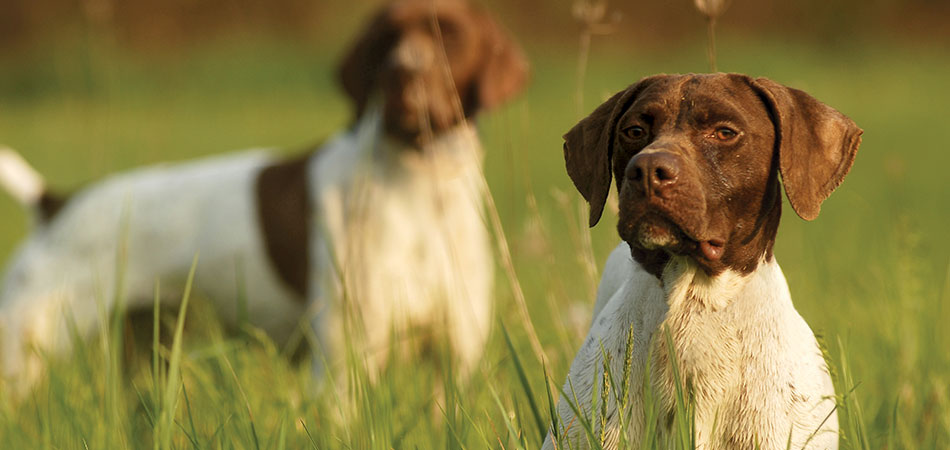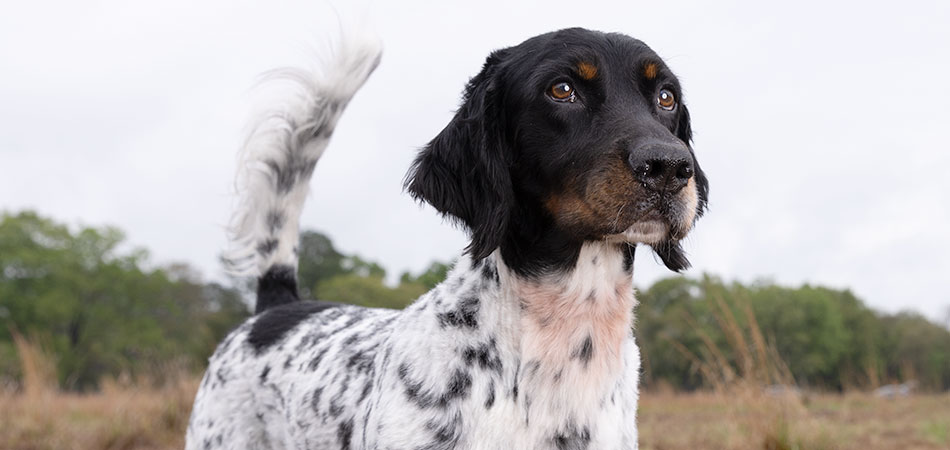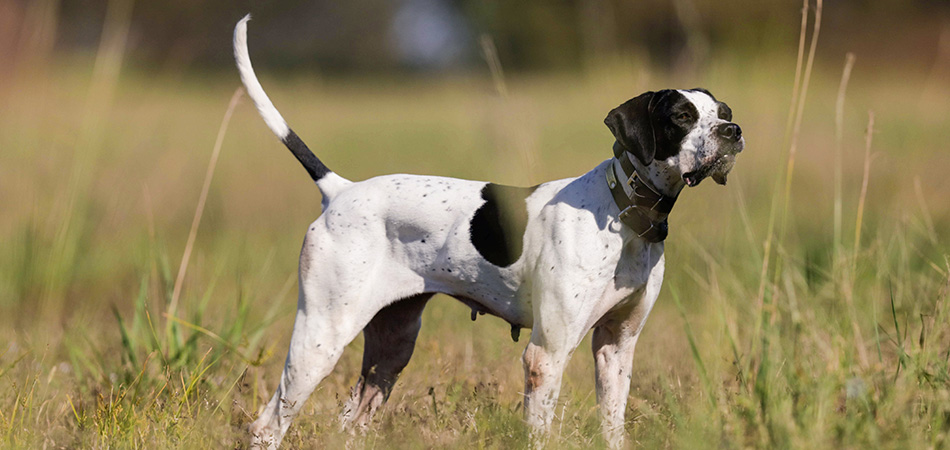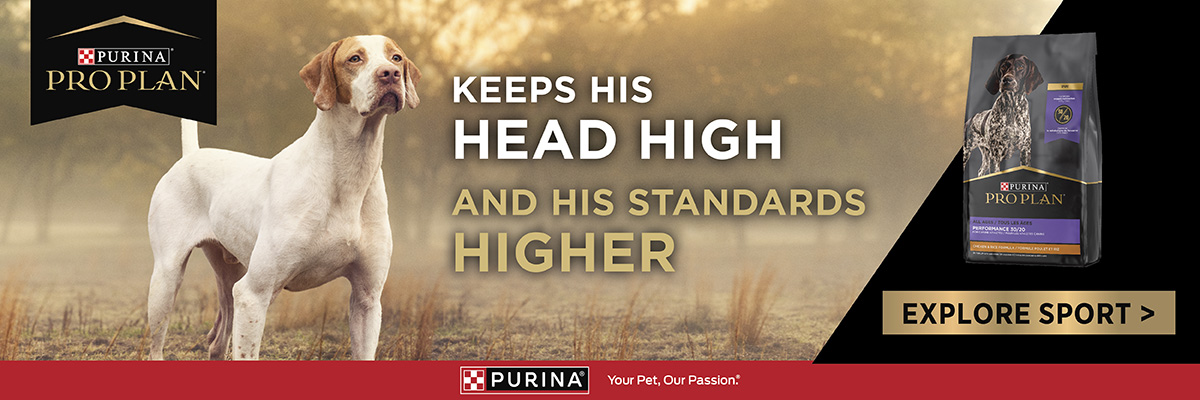 There are a number of culprits that can stress a dog out, such as separation, unfamiliar visitors, a change in weather, loud noises or novel sounds. Sporting dogs, in particular, could demonstrate anxious behaviors over a disruption in routine or location, whether it be due to travel or going to a new trainer.
There are a number of culprits that can stress a dog out, such as separation, unfamiliar visitors, a change in weather, loud noises or novel sounds. Sporting dogs, in particular, could demonstrate anxious behaviors over a disruption in routine or location, whether it be due to travel or going to a new trainer.
“One of the biggest stressors for bird dogs especially is inactivity,” says pro trainer Ike Todd of Todd Kennels in Somerville, Tennessee. “A dog’s anxious behavior is best controlled by regular physical and mental stimulation. Anything you can do to keep your bird dog active, such as running, roading or providing a more spacious kennel or outdoor enclosure, will help promote calmer behavior.”
“What’s more, a dog showing anxiety about training situations, in particular, even after he or she has been adequately exercised, will sometimes respond better when worked with more well-adjusted dogs,” Todd says. “A dog learns by association and being around other willing participants can help boost his or her confidence.”
Anxious behaviors in a dog typically are signaled by pacing, reluctance to accept treats, and excessive barking or panting. An anxious dog living in a state of chronic physiological stress may be prone to chronic health issues.
“It’s important to talk to your veterinarian if your dog is displaying undesirable behaviors,” says Purina Director of Veterinary Technical Communications Jason Gagne, DVM, DACVN. “What might be perceived as just a characteristic of a particular breed or part of a dog’s personality could really be an anxious behavior that needs attention.”
Follow these tips to help manage your dog’s anxious behaviors caused by external stressors.
1. Expose ‘Em Early
First things first. Learning to cope with stressful situations begins during puppyhood. Puppy gyms, or boxes made of PVC frame with various dog toys suspended from ropes or plastic chains, can promote early socialization and sensory stimulation, the foundation for a well-rounded, adaptable dog.
“Anything that involves physical and mental activity for young pups is good,” says Todd. “The more a pup is exposed to, whether it’s a puppy gym or true field-like conditions, the better he or she will be prepared for life as an adult.”
Do your homework before buying a pup and check with prospective breeders on their socialization philosophy.
2. Don’t Set an Expiration Date
A pup should be introduced to the world outside the whelping box, and socialization doesn’t expire once a dog enters adulthood. Continue exposing your dog to new people, places and experiences throughout his or her life, ensuring positive interactions by using common sense and safety considerations.
“Socialization throughout a bird dog’s life is best accomplished through time spent in the field,” Todd explains. “Dogs love it and thrive on it.”
3. Make Noise
A dog should be exposed early and regularly to household noises such as the vacuum cleaner, blow dryer, blender, washing machine and clothes dryer, as well as outdoor noises such as the tractor, lawnmower, weed eater, blower and all-terrain vehicles. Furthermore, a sporting dog should have an early gradual introduction to especially loud sounds to reduce fear of noise.
“Early exposure to loud noises is ideal for a bird dog, provided it’s in a controlled environment,” Todd advises. “Any loud noises should be introduced from a safe distance away initially and be associated with something enjoyable, such as eating or playing, so that whatever is being introduced is associated with a positive experience.”
 4. Practice Makes Perfect
4. Practice Makes Perfect
Ensure your dog is well-accustomed to travel before leaving on any trip. Start by putting your dog in a crate and taking him or her on short errands, increasing the length of time each trip, to gradually condition the dog for riding in a vehicle. The more comfortable your dog is in the car, the longer he or she can ride.
To further desensitize a dog to travel, give him or her plenty of exercise prior to traveling. “Just like a tired child travels better, so too will a bird dog,” says Todd.
5. Calm During the Storm
“A dog with storm anxiety should be given a safe, confined and comfortable space for the duration of a storm,” says Todd. “Anything you can do to help put your dog at ease can help alleviate his or her fear of storms.”
Keep your dog distracted during a storm by offering his or favorite toys and treats and playing light music to drown out rumbling thunder. Products such as the Thundershirt can also help ease storm anxiety.
6. Relax Together
A dog depends on his or her owner for security, so patience and persistence on your part is key to helping your dog be stress-free. Always keep desensitization sessions short and fun, offering praise or a treat for positive interactions.
Purina Pro Plan Veterinary Supplements Launches Probiotic Breakthrough for Helping Dogs Maintain Calm Behavior
What if you could help support your dog with a probiotic to help him or her stay calm? Purina Pro Plan Veterinary Supplements Calming Care is a canine probiotic supplement available through veterinarians, online retailers, and select pet specialty stores containing Bifidobacterium longum (BL999), a probiotic strain shown to help dogs maintain calm behavior.
“The gut is sometimes referred to as a ‘second brain’ because of the bi-directional communication between the gut and the brain,” explains Purina Director of Veterinary Technical Communications Jason Gagne, DVM, DACVN. “There is scientific evidence that manipulating the gut bacteria can also have a positive influence on dogs displaying anxious behavior. For example, Bifidobacterium longum (BL999), the probiotic found in Calming Care, has been shown to help dogs maintain calm behavior.”
“Different strains of probiotics have different effects on the body,” Purina Research Scientist Ragen T.S. McGowan, PhD, says. “In a 15-week blinded crossover design study, we evaluated the effects of administering BL999 to 24 Labrador Retrievers that demonstrated anxious behaviors. By the end of the study, 90 percent of dogs showed an improvement in displaying anxious behaviors, such as excessive vocalization, jumping, pacing and spinning. Dogs in the study also showed improvement in physiological factors, including positive cardiac activity during stressful events1.”
Calming Care helps support dogs with anxious behaviors such as excessive vocalization, jumping, pacing and spinning, and helps them cope with external stressors such as separation, unfamiliar visitors, novel sounds or changes in routine and location. It also helps dogs maintain positive cardiac activity during stressful events, promoting a positive emotional state, and supports a healthy immune system.
Available through veterinarians, Calming Care should be given under your veterinarian’s supervision. If you have concerns about your dog’s behavior, talk to your veterinarian.
1McGowan, R.T.S. (2016). “Oiling the brain” or “Cultivating the gut”: Impact of diet on anxious behaviors in dogs. Proceedings of the Nestlé Purina Companion Animal Nutrition Summit, March 31-April 2, Florida, 91-97.




